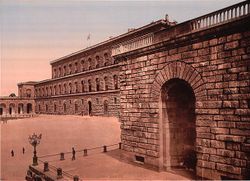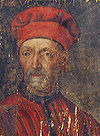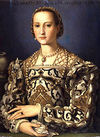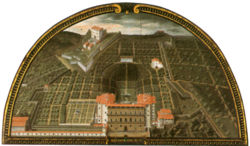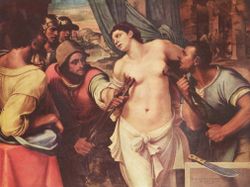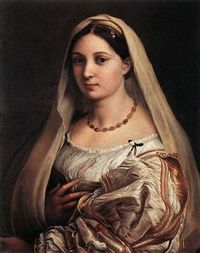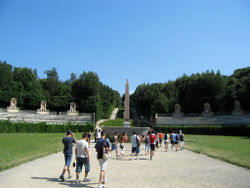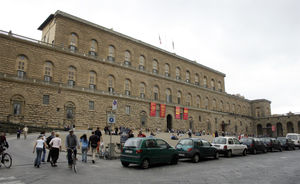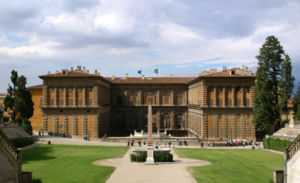Palazzo Pitti
2007 Schools Wikipedia Selection. Related subjects: Architecture
The Palazzo Pitti (sometimes called the Pitti Palace) is a vast mainly Renaissance palace in Florence, Italy. It is situated on the south side of the River Arno, a short distance from the Ponte Vecchio. The core of the present palazzo dates from 1458 and was originally the town residence of Luca Pitti, an ambitious Florentine banker. It was bought by the Medici family in 1539 as the official residence of the ruling families of the Grand Duchy of Tuscany.
In the 19th century, the palazzo, by then a great treasure house, was used as a power base by Napoleon, and later served for a brief period as the principal royal palace of the newly-united Italy. In the early 20th century, the palazzo together with its contents was given to the Italian people by King Victor Emmanuel III; subsequently its doors were opened to the public as one of Florence's largest art galleries. Today, housing several minor additions in addition to those of the Medici family, it is fully open to the public.
History
Early history
The construction of this severe, almost forbidding, building was commissioned in 1458 by the Florentine banker Luca Pitti, a principal supporter and friend of Cosimo de' Medici. The early history of the Palazzo Pitti is a mixture of fact and myth. Pitti wanted to build, it was said, a large palazzo which would outshine the Palazzo Medici. It is claimed that he specifically instructed that the windows should be larger than the entrance of the Palazzo Medici. It has been said by no less a person than Vasari that Brunelleschi was the palazzo's architect, and that his pupil Luca Fancelli was simply his assistant in the task - today it is Fancelli that is generally credited. Besides obvious differences from the elder architect's style, Brunelleschi died 12 years before construction of the palazzo began. The design and fenestration suggest that the unknown architect was more experienced in utilitarian domestic architecture than in the humanist rules defined by Alberti in his book De Re Aedificatoria.
The original palazzo, though impressive, would have been no rival to the magnificence of the Florentine Medici residences in terms of either size or content. Whoever the architect of the Palazzo Pitti was, he was moving against the contemporary flow of fashion. The rusticated stonework gives the palazzo a severe and powerful atmosphere, reinforced by the three times repeated series of seven arch-headed apertures, reminiscent of a Roman aqueduct. The Roman-style architecture appealed to the Florentine love of the new style all'antica. This original design has withstood the test of time, and its influence has been maintained and continued during the subsequent additions to the palazzo. Work stopped after Pitti suffered financial reverses following the death of Cosimo de' Medici in 1464. Luca Pitti died in 1472 with the building uncompleted.
The Medici
The building was sold in 1549 by Buonaccorso Pitti, a descendant of Luca Pitti, to Eleonora di Toledo. Raised at the luxurious court of Naples, Eleonora was the wife of Cosimo I de' Medici of Tuscany, now the Grand Duke. On moving into the palace, Cosimo had Vasari enlarge the structure to fit his tastes; the palace was more than doubled by the addition of a new block onto the rear. Vasari also built an above-ground walkway from Cosimo's old palace, the Palazzo Vecchio, through the Uffizi, above the Ponte Vecchio to the Palazzo Pitti.
Land on the hill called Boboli at the rear of the palazzo was acquired in order to create a large formal park, the Boboli Gardens. The landscape architect employed for this was the Medici court artist Niccolo Tribolo, who died the following year; he was quickly succeeded by Bartolommeo Ammanati. The original design of the gardens centred on an amphitheatre, behind the corps de logis of the palazzo, in which the classically-inspired plays of Florentine playwrights such as Giovan Battista Cini were performed for the amusement of the cultivated Medici court, with elaborate sets designed by the court architect Baldassarre Lanci.
With the garden project well in hand, Ammanati turned his attentions to creating a large courtyard immediately behind the principal facade, to link the palazzo to its new garden. This courtyard has heavy-banded channelled rustication that has been widely copied, notably for the Parisian palais of Maria de' Medici, the Luxembourg. Ammanati also created the finestre inginocchiate("kneeling" windows, in reference to their imagined resemblance to a prie-dieu, a device of Michelangelo's) in the principal facade, replacing the entrance bays at each end. During the years 1558-70, Ammanati created a monumental staircase to lead with more pomp to the piano nobile, and he extended the wings on the garden front that embraced a courtyard excavated into the steeply sloping hillside at the same level as the piazza in front, from which it was visible through the central arch of the basement. On the garden side of the courtyard Amannati constructed a grotto, called the "grotto of Moses" for the porphyry statue that inhabits it. On the terrace above it, level with the piano nobile windows, Ammanati constructed a fountain centered on the axis; it was later replaced by the Fontana del Carciofo ("Fountain of the Artichoke"), designed by Giambologna's former assistant, Francesco Susini, and completed in 1641.
In 1616 a competition was opened to design extensions to the principal urban facade by three bays at either end. Giulio Parigi won the commission; work on the north side began in 1618, and on the south side in 1631 by Alfonso Parigi. During the 18th century, two perpendicular wings were constructed by the architect Giuseppe Ruggeri to enhance and stress the widening of via Romana, which creates a piazza centered on the façade, the prototype of the cour d'honneur that was copied in France. Sporadic lesser additions and alterations were made for many years thereafter under other rulers and architects.
Houses of Lorraine and Savoy
The palazzo remained the principal Medici residence until the last male Medici heir died in 1737, whereupon it passed to the new Grand Dukes of Tuscany, the Austrian House of Lorraine, in the person of Francis I, Holy Roman Emperor. The Austrian tenancy was briefly interrupted by Napoleon, who used the Pitti during his period of control over Italy.
When Tuscany passed from the House of Lorraine to the House of Savoy in 1860, the Palazzo Pitti was included. After the Risorgimento, when Florence was briefly the capital of the Kingdom of Italy, Vittorio Emanuele II resided in the Pitti until 1871. His grandson, Vittorio Emanuele III, presented the Pitti to the nation in 1919. The palazzo and other buildings in the Boboli Gardens then became divided into five separate art galleries and a museum, housing not only many of its original contents, but priceless artifacts from many other collections acquired by the state. The 140 rooms open to the public are part of an interior, which is in large part a later product than the original portion of the structure, mostly created in two phases, one in the 17th century and the other in the early 18th century. Some earlier interiors remain, and there are still later additions such as the Throne Room. In 2005 the surprise discovery of forgotten 18th-century bathrooms in the palazzo revealed remarkable examples of contemporary plumbing very similar in style to the bathrooms of the 21st century.
Palazzo Pitti galleries
The palazzo is now the largest museum complex in Florence. The principal palazzo block, often in a building of this design known as the corps de logis, is 32,000 square metres. It is divided into several principal galleries or museums detailed below.
Palatine Gallery
The Palatine Gallery, on the first floor of the piano nobile, is perhaps the most famous of the galleries, a large ensemble of over 500 principally Renaissance paintings, which were once part of the Medicis' and their successors' private art collection. The gallery, which overflows into the royal apartments, contains works by Raphael, Titian, Correggio, Rubens, and Pietro da Cortona. The character of the gallery is still that of a private collection, and the works of art are displayed and hung much as they would have been in the grand rooms for which they were intended rather than following a chronological sequence, or arranged according to school of art.
The finest rooms were decorated by Pietro da Cortona in the high baroque style. Cortona's huge, well-received, frescoes depicting the Age of Gold and Age of Silver in the Salla della Stuffa were painted in 1637, and followed in 1641 by the Age of Copper and Age of Iron. Representing the turmoil of life, they are regarded among his masterpieces. The artist was subsequently asked to fresco a suite of seven rooms at the front of the palazzo. The theme for these was to be the astrological influence on the life of the ruler. By 1647, when Cortona left Florence, he had finished only three rooms, Mars, Jupiter and Venus, they were to inspire the later Planet Rooms at Louis XIV's Versailles, designed by Le Brun. The other rooms were completed in the 1660s by Ciro Ferri.
The collection was first opened to the public in the late 18th century, albeit rather reluctantly, by Grand Duke Pietro Leopoldo, Tuscany's first enlightened ruler, keen to obtain popularity after the demise of the Medici.
Royal Apartments
This is a suite of 14 rooms, formerly used by the Medici family, and lived in by their successors. These rooms have been largely altered since the era of the Medici, most recently in the 19th century. They contain a collection of Medici portraits, many of them by the artist Giusto Sustermans. In contrast to the great salons containing the Palatine collection, some of these rooms are much smaller and more intimate, and, while still grand and gilded, more suited to day to day living requirements. Period furnishings include four-poster beds and other necessary furnishings not found elsewhere in the palazzo. The Kings of Italy last used the Palazzo Pitti in the 1920s. By that time it had already been converted to a museum, but a suite of rooms (now the Gallery of Modern Art) was reserved for them when visiting Florence officially.
Gallery of Modern Art
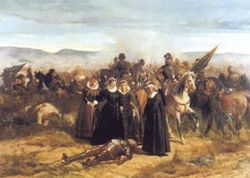
This large collection, spread over 30 rooms, includes works by artists of the Macchiaioli movement and of other modern Italian schools of the late 19th and early 20th centuries. The pictures by the Macchiaioli artists are of particular note, as this school of 19th-century Tuscan painters led by Giovanni Fattori were early pioneers and the founders of the impressionist movement. The title gallery of modern art, to some, may sound incorrect, as the art in the gallery covers the period from 1700 to early 1900. No examples of later art are included in the collection. This is because in Italy "Modern Art" refers to the period before World War II what has followed since that period is generally known as "Contemporary Art" (arte contemporanea). In Tuscany this art can be found at the Centro per l'arte contemporanea Luigi Pecci at Prato, a city a short distance of approximately 15 Kilometers from Florence.
Silver Museum
The Silver Museum, sometimes called "The Medici Treasury", contains a collection of priceless silver, cameos, and works in semi-precious gemstones, many of the latter from the collection of Lorenzo de' Medici, including his collection of ancient vases, many with delicate silver gilt mounts added for display purposes in the 15th century. These rooms, formerly part of the private royal apartments, are decorated with 17th-century frescoes, the most splendid being by Giovanni di San Giovanni, from 1635 to 1636. The Silver Museum also contains a fine collection of German gold and silver artefacts purchased by Grand Duke Ferdinand after his return from exile in 1815, following the French occupation.
Porcelain Museum
First opened in 1973, this museum is housed in the Casino del Cavaliere in the Boboli Gardens. The porcelain is from many of the most notable European porcelain factories, Sèvres, Meissen, and Dresden being well represented. Many items in the collection were gifts to the Florentine rulers from other European sovereigns, while other works were specially commissioned by the Grand Ducal court. Of particular note are several large dinner services by Vincennes factory, later renamed Sèvres, and a collection of small biscuit figurines.
Costume Gallery
This gallery, situated in a wing of the palazzo known as the "Palazzina della Meridiana", contains a collection of theatrical costumes dating from the 16th century until the present. It is also the only museum in Italy detailing the history of Italian fashions. One of the newer collections to the palazzo, it was founded in 1983 by Kristen Aschengreen Piacenti; it displays in addition to the theatrical costumes, garments worn between the 18th century and the present day. Some of the exhibits are peculiar to the Palazzo Pitti; these include the 16th-century funeral clothes of Grand Duke Cosimo I de' Medici, and Eleonora of Toledo, and her son Garzia, both of whom died of malaria. Their bodies would have been displayed in state wearing the finest clothes, before being reclothed in more simple attire before interment. The gallery also exhibits a collection of mid-20th century costume jewellery.
Carriages Museum
This ground floor museum exhibits carriages and other conveyances used by the grand ducal court mainly in the late 18th and 19th century. Some of these carriages are highly decorative, being adorned by not only gilt but painted landscapes on their panels. Those which were used on the grandest occasions, such as the "Carrozza d'Oro" (golden carriage) are surmounted by gilt crowns which would have indicated the rank and station of the carriage's occupants. Other carriages on view are those used by the King of the Two Sicilies, and Archbishops and other Florentine dignitaries.
The Palazzo today
Compared to many of Italy's great palazzi the exterior of the Palazzo Pitti at first glance pales: the palazzo does not have the overpowering and commanding presence of Caserta or the citadel features of the Royal Palace of Turin, nor the elegance of the Naples Palace or Rome's papal, later royal, palace, the Quirinal, both with facades by Domenico Fontana. The Palazzo Pitti's architectural merit is in its great severity and simplicity. One continual architectural theme used throughout four centuries has produced massive but impressive elevations and facades which belie the long evolution and history of the structure. The architecture commands attention by virtue of size, strength and the reflection of the sun on the glass and stone, coupled with the repetitive, almost monotonous theme. Ornament and elegance of design take second place to the vast and solid mass of rusticated stonework relieved solely by the arcade-like frequency of the arched window embrasures. As with many Italian palazzi one has to enter the building in order to truly appreciate its architecture.
Control of the palazzo, today transformed from royal palace to museum, is in the hands of the Italian state through the "Polo Museale Fiorentino", an institution which administers twenty museums, including the Uffizi Gallery, and has ultimate responsibility for 250,000 catalogued works of art. In spite of its metamorphosis from royal residence to a state-owned public building, the palazzo, sitting on its elevated site overlooking Florence, still retains the air and atmosphere of a private collection in a grand house. This is to a great extent thanks to the organisation "Amici di Palazzo Pitti" (Friends of the Palazzo Pitti), a group of volunteers and patrons founded in 1996, which raises funds and makes suggestions for the ongoing maintenance of the palazzo and the collections, and for the continuing improvement of their visual display.
Now in its sixth century, the Palazzo Pitti is more splendid and better maintained than at any time in its history. Florence receives over five million visitors each year, and for many of these the Palazzo Pitti is an essential stop. Thus the palazzo still impresses visitors with the splendours of Florence, the purpose for which, it was originally built.
